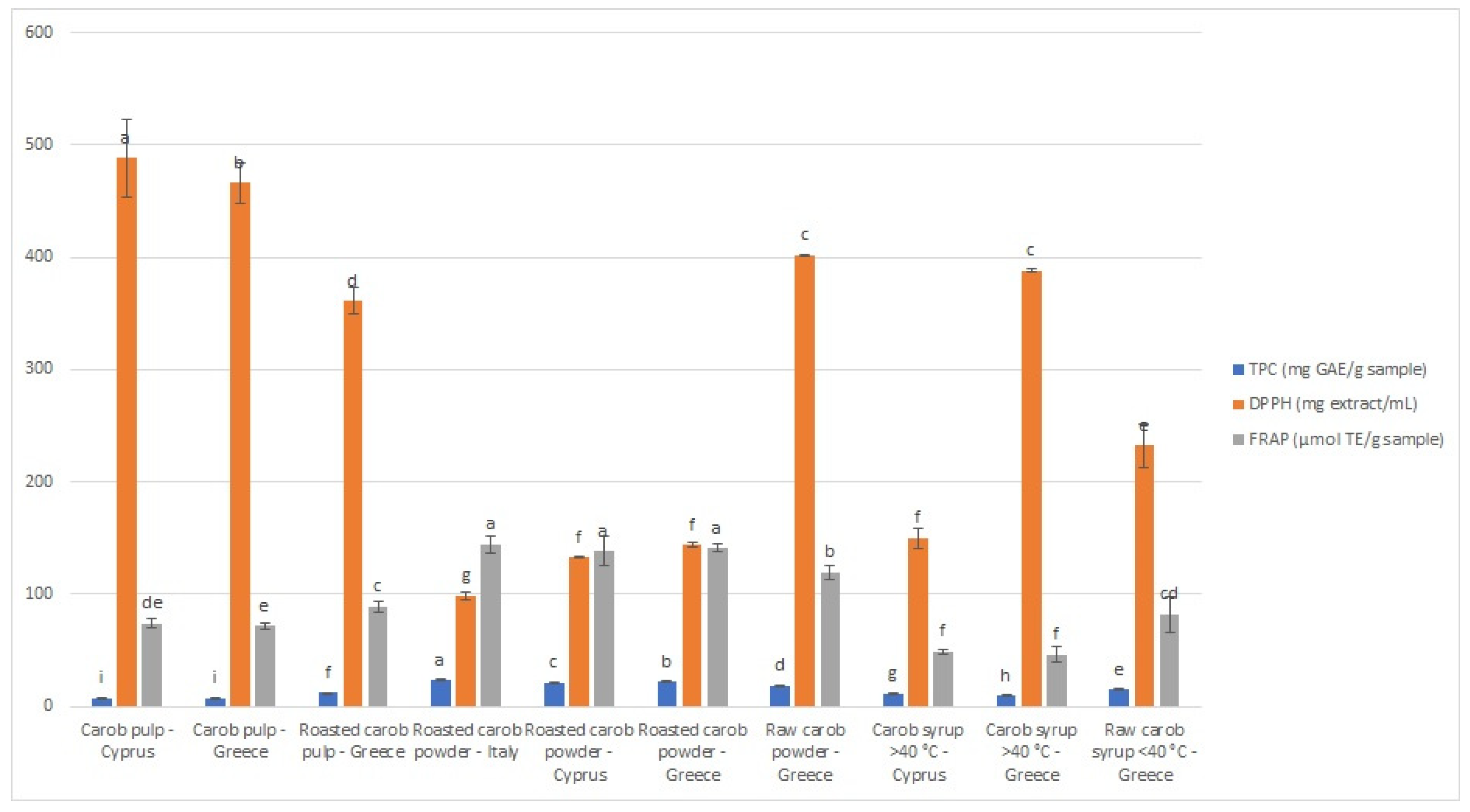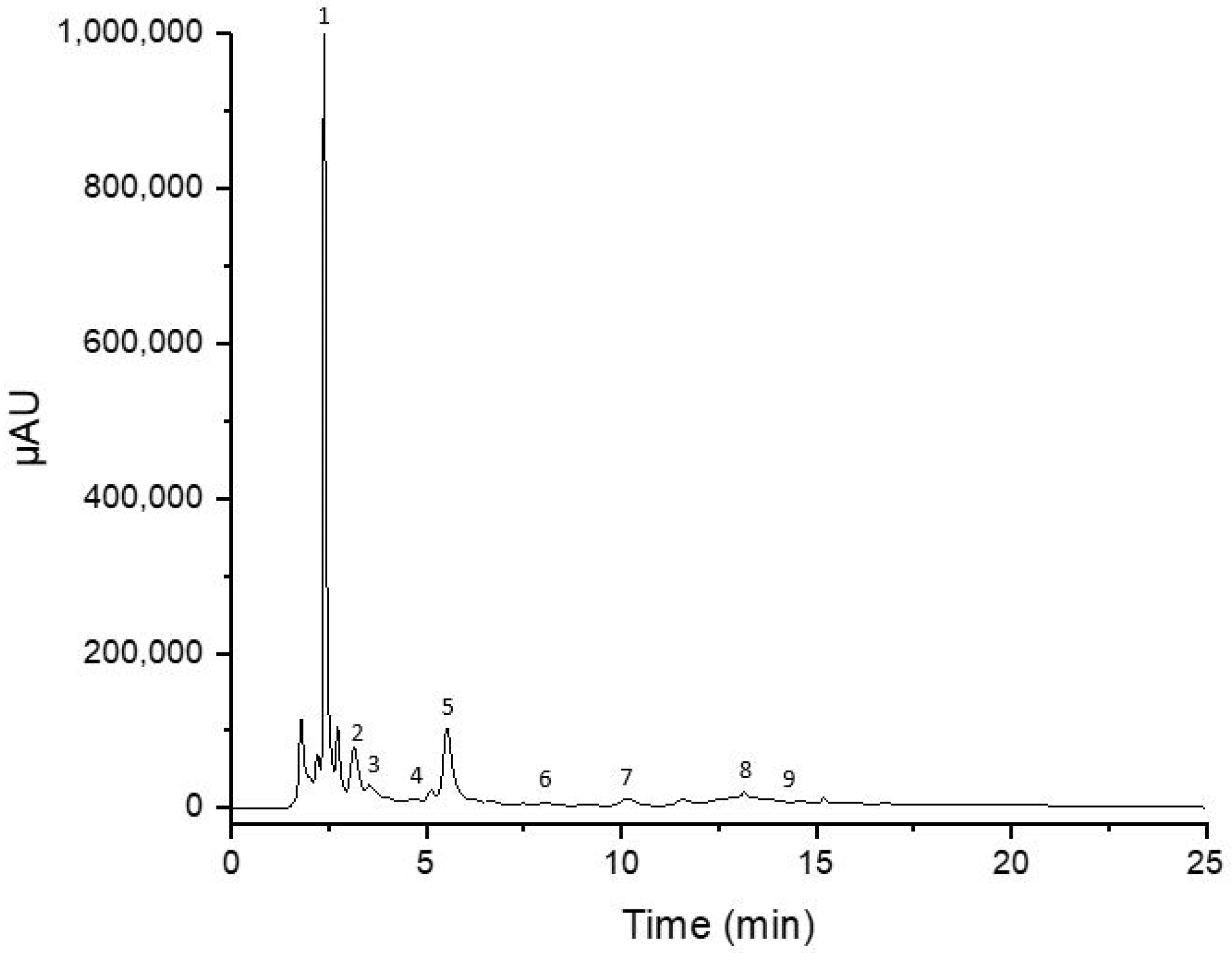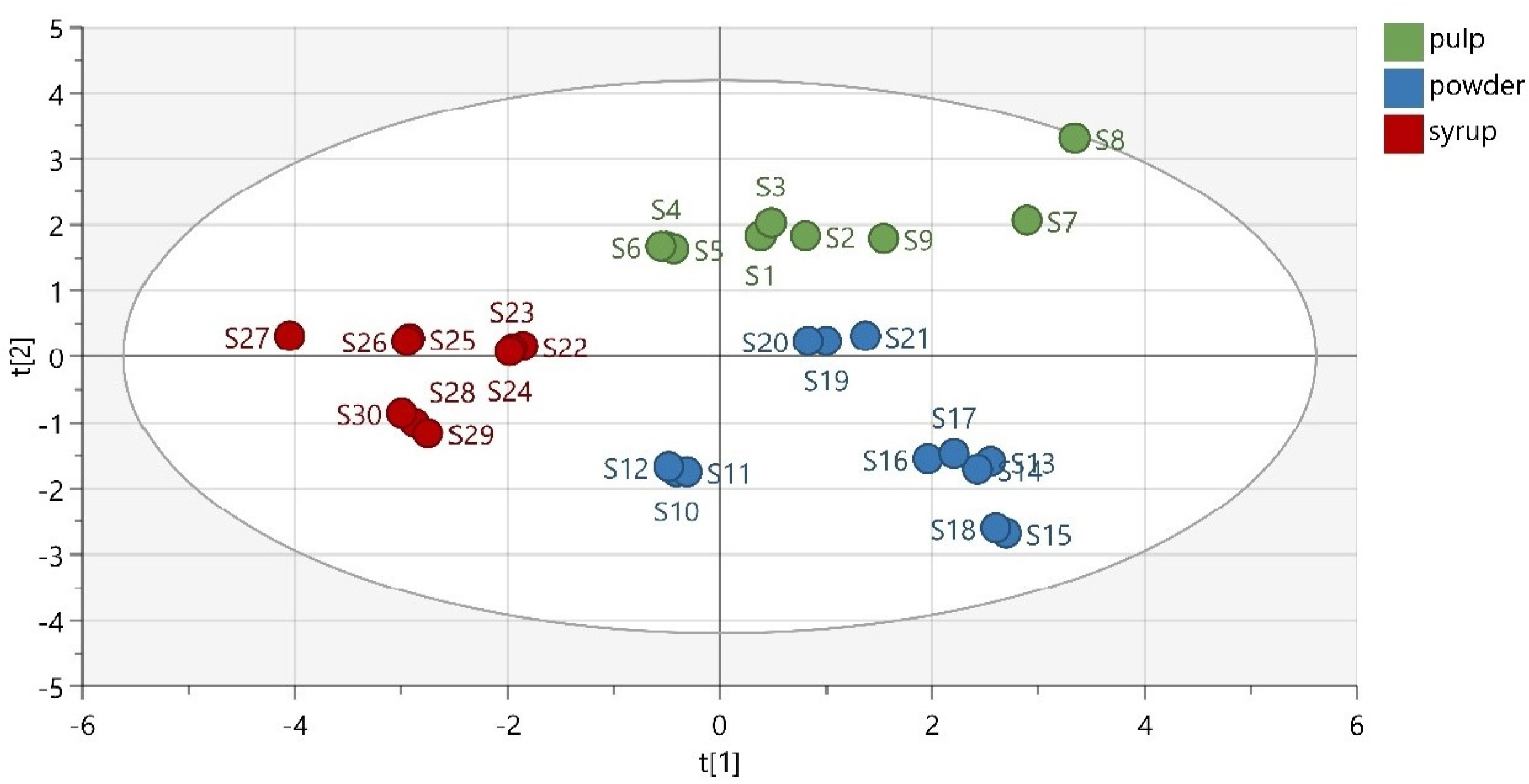Phenolic Profile, Antioxidant Activity, and Chemometric Classification of Carob Pulp and Products
Abstract
1. Introduction
2. Results and Discussion
2.1. Spectrophotometric Analysis
2.1.1. Total Phenolic Content
2.1.2. Antioxidant Activity
2.2. Chromatographic Analysis
2.2.1. Method Validation
2.2.2. Polyphenolic Profile via HPLC Analysis
2.3. Chemometric Analysis
3. Materials and Methods
3.1. Standards and Reagents
3.2. Plant Material and Commercial Samples
3.3. Extraction Procedure
3.4. Total Phenolic Content Using the Folin–Ciocalteau Method
3.5. Radical Scavenging Activity by DPPH Assay
3.6. Ferric Reducing Antioxidant Power (FRAP Assay)
3.7. Solid-Phase Extraction
3.8. HPLC-DAD
3.9. Data Analysis
4. Conclusions
Supplementary Materials
Author Contributions
Funding
Institutional Review Board Statement
Informed Consent Statement
Data Availability Statement
Conflicts of Interest
References
- Kyratzis, A.C.; Antoniou, C.; Papayiannis, L.C.; Graziani, G.; Rouphael, Y.; Kyriacou, M.C. Pod Morphology, Primary and Secondary Metabolite Profiles in Non-Grafted and Grafted Carob Germplasm Are Configured by Agro-Environmental Zone, Genotype, and Growing Season. Front. Plant Sci. 2021, 11, 612376. [Google Scholar] [CrossRef] [PubMed]
- Goulas, V.; Stylos, E.; Chatziathanasiadou, M.V.; Mavromoustakos, T.; Tzakos, A.G. Functional Components of Carob Fruit: Linking the Chemical and Biological Space. Int. J. Mol. Sci. 2016, 17, 1875. [Google Scholar] [CrossRef]
- Antoniou, C.; Kyratzis, A.; Rouphael, Y.; Stylianou, S.; Kyriacou, M.C. Heat- And Ultrasound-Assisted Aqueous Extraction of Soluble Carbohydrates and Phenolics from Carob Kibbles of Variable Size and Source Material. Foods 2020, 9, 364. [Google Scholar] [CrossRef]
- Van Rijs, P.; Fogliano, V. Roasting Carob Flour Decreases the Capacity to Bind Glycoconjugates of Bile Acids. Food Funct. 2020, 11, 5924–5932. [Google Scholar] [CrossRef]
- Cavdarova, M.; Makris, D.P. Extraction Kinetics of Phenolics from Carob (Ceratonia siliqua L.) Kibbles Using Environmentally Benign Solvents. Waste Biomass Valorization 2014, 5, 773–779. [Google Scholar] [CrossRef]
- Christou, A.; Martinez-piernas, A.B.; Stavrou, I.J.; Garcia-reyes, J.F.; Kapnissi-christodoulou, C.P. HPLC-ESI-HRMS and Chemometric Analysis of Carobs Polyphenols–Technological and Geographical Parameters Affecting Their Phenolic Composition. J. Food Compos. Anal. 2022, 114, 104744. [Google Scholar] [CrossRef]
- Kokkinofta, R.; Yiannopoulos, S.; Stylianou, M.A.; Agapiou, A. Use of Chemometrics for Correlating Carobs Nutritional Compositional Values with Geographic Origin. Metabolites 2020, 10, 62. [Google Scholar] [CrossRef] [PubMed]
- Christou, A.; Stavrou, I.J.; Kapnissi-Christodoulou, C.P. Continuous and Pulsed Ultrasound-Assisted Extraction of Carob’s Antioxidants: Processing Parameters Optimization and Identification of Polyphenolic Composition. Ultrason. Sonochem. 2021, 76, 105630. [Google Scholar] [CrossRef]
- Chait, Y.A.; Gunenc, A.; Bendali, F.; Hosseinian, F. Simulated Gastrointestinal Digestion and in Vitro Colonic Fermentation of Carob Polyphenols: Bioaccessibility and Bioactivity. Lwt 2020, 117, 108623. [Google Scholar] [CrossRef]
- Stavrou, I.J.; Christou, A.; Kapnissi-Christodoulou, C.P. Polyphenols in Carobs: A Review on Their Composition, Antioxidant Capacity and Cytotoxic Effects, and Health Impact. Food Chem. 2018, 269, 355–374. [Google Scholar] [CrossRef]
- Christodoulou, M.C.; Orellana Palacios, J.C.; Hesami, G.; Jafarzadeh, S.; Lorenzo, J.M.; Domínguez, R.; Moreno, A.; Hadidi, M. Spectrophotometric Methods for Measurement of Antioxidant Activity in Food and Pharmaceuticals. Antioxidants 2022, 11, 2213. [Google Scholar] [CrossRef]
- Scalbert, A.; Manach, C.; Morand, C.; Rémésy, C.; Jiménez, L. Dietary Polyphenols and the Prevention of Diseases. Crit. Rev. Food Sci. Nutr. 2005, 45, 287–306. [Google Scholar] [CrossRef] [PubMed]
- Ruiz-Roso, B.; Quintela, J.C.; de la Fuente, E.; Haya, J.; Pérez-Olleros, L. Insoluble Carob Fiber Rich in Polyphenols Lowers Total and Ldl Cholesterol in Hypercholesterolemic Sujects. Plant Foods Hum. Nutr. 2010, 65, 50–56. [Google Scholar] [CrossRef] [PubMed]
- Gregoriou, G.; Neophytou, C.M.; Vasincu, A.; Gregoriou, Y.; Hadjipakkou, H.; Pinakoulaki, E.; Christodoulou, M.C.; Ioannou, G.D.; Stavrou, I.J.; Christou, A.; et al. Anti-Cancer Activity and Phenolic Content of Extracts Derived from Cypriot Carob (Ceratonia siliqua L.) Pods Using Different Solvents. Molecules 2021, 26, 5017. [Google Scholar] [CrossRef]
- Vekiari, S.A.; Ouzounidou, G.; Ozturk, M.; Görk, G. Variation of Quality Characteristics in Greek and Turkish Carob Pods during Fruit Development. Procedia-Soc. Behav. Sci. 2011, 19, 750–755. [Google Scholar] [CrossRef]
- Saci, F.; Bachir bey, M.; Louaileche, H.; Gali, L.; Bensouici, C. Changes in Anticholinesterase, Antioxidant Activities and Related Bioactive Compounds of Carob Pulp (Ceratonia siliqua L.) during Ripening Stages. J. Food Meas. Charact. 2020, 14, 937–945. [Google Scholar] [CrossRef]
- Quiles-Carrillo, L.; Mellinas, C.; Garrigos, M.C.; Balart, R.; Torres-Giner, S. Optimization of Microwave-Assisted Extraction of Phenolic Compounds with Antioxidant Activity from Carob Pods. Food Anal. Methods 2019, 12, 2480–2490. [Google Scholar] [CrossRef]
- Roseiro, L.B.; Tavares, C.S.; Roseiro, J.C.; Rauter, A.P. Antioxidants from Aqueous Decoction of Carob Pods Biomass (Ceretonia siliqua L.): Optimisation Using Response Surface Methodology and Phenolic Profile by Capillary Electrophoresis. Ind. Crops Prod. 2013, 44, 119–126. [Google Scholar] [CrossRef]
- Petkova, N.; Petrova, I.; Ivanov, I.; Mihov, R.; Hadjikinova, R.; Ognyanov, M.; Nikolova, V. Nutritional and Antioxidant Potential of Carob (Ceratonia siliqua) Flour and Evaluation of Functional Properties of Its Polysaccharide Fraction. J. Pharm. Sci. Res. 2017, 9, 2189–2195. [Google Scholar]
- Roseiro, L.B.; Duarte, L.C.; Oliveira, D.L.; Roque, R.; Bernardo-Gil, M.G.; Martins, A.I.; Sepúlveda, C.; Almeida, J.; Meireles, M.; Gírio, F.M.; et al. Supercritical, Ultrasound and Conventional Extracts from Carob (Ceratonia siliqua L.) Biomass: Effect on the Phenolic Profile and Antiproliferative Activity. Ind. Crops Prod. 2013, 47, 132–138. [Google Scholar] [CrossRef]
- Benchikh, Y.; Louaileche, H.; George, B.; Merlin, A. Changes in Bioactive Phytochemical Content and in Vitro Antioxidant Activity of Carob (Ceratonia siliqua L.) as Influenced by Fruit Ripening. Ind. Crops Prod. 2014, 60, 298–303. [Google Scholar] [CrossRef]
- Goulas, V.; Georgiou, E. Utilization of Carob Fruit as Sources of Phenolic Compounds with Antioxidant Potential: Extraction Optimization and Application in Food Models. Foods 2020, 9, 20. [Google Scholar] [CrossRef] [PubMed]
- Owen, R.W.; Haubner, R.; Hull, W.E.; Erben, G.; Spiegelhalder, B.; Bartsch, H.; Haber, B. Isolation and Structure Elucidation of the Major Individual Polyphenols in Carob Fibre. Food Chem. Toxicol. 2003, 41, 1727–1738. [Google Scholar] [CrossRef]
- Rakib, E.M.; Chicha, H.; Abouricha, S.; Alaoui, M. Determination of Phenolic Composition of Carob Pods Grown in Different Regions of Morocco. J. Nat. Prod. 2010, 3, 134–140. [Google Scholar]
- Christou, A.; Stavrou, I.J.; Kapnissi-Christodoulou, C.P. Combined Use of β-Cyclodextrin and Ionic Liquid as Electrolyte Additives in EKC for Separation and Determination of Carob’s Phenolics—A Study of the Synergistic Effect. Electrophoresis 2021, 42, 1945–1955. [Google Scholar] [CrossRef]
- Papagiannopoulos, M.; Wollseifen, H.R.; Mellenthin, A.; Haber, B.; Galensa, R. Identification and Quantification of Polyphenols in Carob Fruits (Ceratonia siliqua L.) and Derived Products by HPLC-UV-ESI/MSn. J. Agric. Food Chem. 2004, 52, 3784–3791. [Google Scholar] [CrossRef]
- Krokou, A.; Kokkinofta, R.; Stylianou, M.; Agapiou, A. Decoding Carob Flavor Aroma Using HS–SPME–GC–MS and Chemometrics. Eur. Food Res. Technol. 2020, 246, 1419–1428. [Google Scholar] [CrossRef]
- Papaefstathiou, E.; Agapiou, A.; Giannopoulos, S.; Kokkinofta, R. Nutritional Characterization of Carobs and Traditional Carob Products. Food Sci. Nutr. 2018, 6, 2151–2161. [Google Scholar] [CrossRef]
- Alabdi, F.; Elharfi, N.; Balouki, A.; Kzaiber, F.; Oussama, A. Carob Origin Classification by FTIR Spectroscopy and Chemometrics. J. Chem. Chem. Eng 2011, 5, 1020–1029. [Google Scholar]
- Christou, C.; Agapiou, A.; Kokkinofta, R. Use of FTIR Spectroscopy and Chemometrics for the Classification of Carobs Origin. J. Adv. Res. 2018, 10, 1–8. [Google Scholar] [CrossRef]
- Farag, M.A.; El-Kersh, D.M.; Ehrlich, A.; Choucry, M.A.; El-Seedi, H.; Frolov, A.; Wessjohann, L.A. Variation in Ceratonia Siliqua Pod Metabolome in Context of Its Different Geographical Origin, Ripening Stage and Roasting Process. Food Chem. 2019, 283, 675–687. [Google Scholar] [CrossRef]
- Eldeeb, G.S.S.; Mosilhey, S.H. Roasting Temperature Impact on Bioactive Compounds and PAHs in Carob Powder (Ceratonia siliqua L.). J. Food Sci. Technol. 2022, 59, 105–113. [Google Scholar] [CrossRef]
- Şahin, H.; Topuz, A.; Pischetsrieder, M.; Özdemir, F. Effect of Roasting Process on Phenolic, Antioxidant and Browning Properties of Carob Powder. Eur. Food Res. Technol. 2009, 230, 155–161. [Google Scholar] [CrossRef]
- Kyriacou, M.C.; Antoniou, C.; Rouphael, Y.; Graziani, G.; Kyratzis, A. Mapping the Primary and Secondary Metabolomes of Carob (Ceratonia siliqua L.) Fruit and Its Postharvest Antioxidant Potential at Critical Stages of Ripening. Antioxidants 2021, 10, 57. [Google Scholar] [CrossRef] [PubMed]
- Žugić, A.; Dordević, S.; Arsić, I.; Marković, G.; Živković, J.; Jovanović, S.; Tadić, V. Antioxidant Activity and Phenolic Compounds in 10 Selected Herbs from Vrujci Spa, Serbia. Ind. Crops Prod. 2014, 52, 519–527. [Google Scholar] [CrossRef]
- Sethi, S.; Joshi, A.; Arora, B.; Bhowmik, A.; Sharma, R.R.; Kumar, P. Significance of FRAP, DPPH, and CUPRAC Assays for Antioxidant Activity Determination in Apple Fruit Extracts. Eur. Food Res. Technol. 2020, 246, 591–598. [Google Scholar] [CrossRef]
- Ou, B.; Huang, D.; Hampsch-Woodill, M.; Flanagan, J.A.; Deemer, E.K. Analysis of Antioxidant Activities of Common Vegetables Employing Oxygen Radical Absorbance Capacity (ORAC) and Ferric Reducing Antioxidant Power (FRAP) Assays: A Comparative Study. J. Agric. Food Chem. 2002, 50, 3122–3128. [Google Scholar] [CrossRef]
- Huma, Z.E.; Jayasena, V.; Nasar-Abbas, S.M.; Imran, M.; Khan, M.K. Process Optimization of Polyphenol Extraction from Carob (Ceratonia siliqua) Kibbles Using Microwave-Assisted Technique. J. Food Process. Preserv. 2018, 42, e13450. [Google Scholar] [CrossRef]
- Benchikh, Y.; Louailèche, H. Effects of Extraction Conditions on the Recovery of Phenolic Compounds and in Vitro Antioxidant Activity of Carob (Ceratonia siliqua L.) Pulp. Acta Bot. Gall. 2014, 161, 175–181. [Google Scholar] [CrossRef]
- Buchner, N.; Krumbein, A.; Rohn, S.; Kroh, L.W. Effect of Thermal Processing on the Flavonols Rutin and Quercetin. Rapid Commun. Mass Spectrom. 2006, 20, 3229–3235. [Google Scholar] [CrossRef]
- Singleton, V.L.; Rossi, J.A. Colorimetry of Total Phenolics with Phosphomolybdic-Phosphotungstic Acid Reagents. Am. J. Enol. Vitic. 1965, 16, 144–158. [Google Scholar]
- Benzie, I.F.F.; Strain, J.J. The Ferric Reducing Ability of Plasma (FRAP) as a Measure of ‘Antioxidant Power’: The FRAP Assay. Anal. Biochem. 1996, 239, 70–76. [Google Scholar] [CrossRef] [PubMed]
- Kumar, N.; Bhandari, P.; Singh, B.; Gupta, A.P.; Kaul, V.K. Reversed Phase-HPLC for Rapid Determination of Polyphenols in Flowers of Rose Species. J. Sep. Sci. 2008, 31, 262–267. [Google Scholar] [CrossRef] [PubMed]
- Trygg, J.; Holmes, E.; Lundstedt, T. Chemometrics in Metabonomics. J. Proteome Res. 2007, 6, 469–479. [Google Scholar] [CrossRef] [PubMed]




| Compounds | Rt ± SD | Linear Range | Regression Equation | R2 | LOD (μg/mL) | LOQ (μg/mL) | Precision | |
|---|---|---|---|---|---|---|---|---|
| Intraday | Interday | |||||||
| Gallic Acid | 2.52 ± 0.00 | 0.05–0.0001 | y = 99234156x − 35103 | 0.999 | 0.7 | 2.1 | 1.00 | 0.92 |
| Catechin | 3.34 ± 0.02 | 0.05–0.0001 | y = 13269933x − 2012 | 0.999 | 0.3 | 0.9 | 0.95 | 2.53 |
| Epicatechin | 3.83 ± 0.03 | 0.01–0.0001 | y = 16600346x + 2404 | 0.998 | 0.3 | 0.8 | 1.04 | 1.47 |
| Caffeic Acid | 4.54 ± 0.05 | 0.01–0.0001 | y = 55118151x + 8713 | 0.997 | 0.3 | 1.0 | 0.47 | 1.96 |
| Rutin | 5.54 ± 0.07 | 0.05–0.0001 | y = 23176073x − 12698 | 0.998 | 0.9 | 2.8 | 0.55 | 1.80 |
| Sinapic Acid | 7.99 ± 0.06 | 0.01–0.0001 | y = 39382578x + 2882 | 0.997 | 0.4 | 1.1 | 0.33 | 1.92 |
| Quercitrin | 11.49 ± 0.08 | 0.01–0.0001 | y = 12295377x − 1169 | 0.999 | 0.1 | 0.3 | 0.42 | 1.84 |
| Myricetin | 13.12 ± 0.03 | 0.01–0.0001 | y = 25427092x + 2679 | 0.998 | 0.3 | 0.9 | 0.90 | 2.68 |
| Quercetin | 14.67 ± 0.04 | 0.01–0.0001 | y = 34063703x + 42715 | 0.998 | 0.3 | 0.9 | 0.32 | 1.67 |
| Compounds | Concentration (mg/g Product) | |||||||||
|---|---|---|---|---|---|---|---|---|---|---|
| Carob Pulp | Carob Powder | Carob Syrup | ||||||||
| Unroasted | Roasted | Roasted | Unroasted | >40 °C | <40 °C | |||||
| Cyprus | Greece | Italy | Cyprus | Greece | Cyprus | Greece | ||||
| Gallic Acid | 0.31 ± 0.01 e | 0.23 ± 0.01 e | 0.40 ± 0.02 d | 0.56 ± 0.07 c | 0.65 ± 0.09 c | 0.61 ± 0.05 c | 0.60 ± 0.05 c | 0.46 ± 0.01 d | 0.99 ± 0.03 b | 1.34 ± 0.03 a |
| Catechin | 0.47 ± 0.04 b | 0.33 ± 0.01 cd | 0.66 ± 0.07 a | 0.24 ± 0.03 d | 0.49 ± 0.05 b | 0.45 ± 0.02 bc | 0.55 ± 0.08 ab | 0.43 ± 0.04 bc | 0.04 ± 0.00 e | 0.06 ± 0.00 e |
| Epicatechin | 0.11 ± 0.02 c | 0.05 ± 0.00 de | 0.14 ± 0.05 bc | 0.02 ± 0.00 def | 0.17 ± 0.01 a | 0.16 ± 0.01 ab | 0.05 ± 0.01 d | ND f | 0.03 ± 0.00 def | 0.02 ± 0.00 ef |
| Caffeic Acid | ND b | NQ b | ND b | ND b | NQ b | NQ b | NQ b | ND b | 0.03 ± 0.01 a | 0.03 ± 0.00 a |
| Rutin | 0.89 ± 0.06 a | 0.50 ± 0.03 c | 0.80 ± 0.09 a | 0.21 ± 0.03 d | 0.82 ± 0.16 a | 0.81 ± 0.08 a | 0.66 ± 0.08 b | ND e | NQ e | NQ e |
| Sinapic Acid | ND d | ND d | NQ d | NQ d | 0.02 ± 0.00 b | 0.02 ± 0.00 c | 0.02 ± 0.00 a | ND d | NQ d | ND d |
| Quercitrin | 0.03 ± 0.01 c | 0.04 ± 0.00 c | 0.34 ± 0.02 a | ND d | 0.05 ± 0.01 c | 0.04 ± 0.00 c | 0.12 ± 0.02 b | ND d | ND d | ND d |
| Myricetin | 0.03 ± 0.00 cd | 0.03 ± 0.00 cd | 0.05 ± 0.01 a | ND e | 0.05 ± 0.01 ab | 0.04 ± 0.01 bc | 0.02 ± 0.00 d | ND e | ND e | ND e |
| Quercetin | 0.02 ± 0.00 c | 0.02 ± 0.00 b | NQ d | 0.03 ± 0.00 a | NQ d | NQ d | ND d | ND d | ND d | ND d |
| Total | 1.86 | 1.20 | 2.40 | 1.06 | 2.25 | 2.13 | 2.03 | 0.79 | 1.09 | 1.44 |
Disclaimer/Publisher’s Note: The statements, opinions and data contained in all publications are solely those of the individual author(s) and contributor(s) and not of MDPI and/or the editor(s). MDPI and/or the editor(s) disclaim responsibility for any injury to people or property resulting from any ideas, methods, instructions or products referred to in the content. |
© 2023 by the authors. Licensee MDPI, Basel, Switzerland. This article is an open access article distributed under the terms and conditions of the Creative Commons Attribution (CC BY) license (https://creativecommons.org/licenses/by/4.0/).
Share and Cite
Ioannou, G.D.; Savva, I.K.; Christou, A.; Stavrou, I.J.; Kapnissi-Christodoulou, C.P. Phenolic Profile, Antioxidant Activity, and Chemometric Classification of Carob Pulp and Products. Molecules 2023, 28, 2269. https://doi.org/10.3390/molecules28052269
Ioannou GD, Savva IK, Christou A, Stavrou IJ, Kapnissi-Christodoulou CP. Phenolic Profile, Antioxidant Activity, and Chemometric Classification of Carob Pulp and Products. Molecules. 2023; 28(5):2269. https://doi.org/10.3390/molecules28052269
Chicago/Turabian StyleIoannou, Georgia D., Ioanna K. Savva, Atalanti Christou, Ioannis J. Stavrou, and Constantina P. Kapnissi-Christodoulou. 2023. "Phenolic Profile, Antioxidant Activity, and Chemometric Classification of Carob Pulp and Products" Molecules 28, no. 5: 2269. https://doi.org/10.3390/molecules28052269
APA StyleIoannou, G. D., Savva, I. K., Christou, A., Stavrou, I. J., & Kapnissi-Christodoulou, C. P. (2023). Phenolic Profile, Antioxidant Activity, and Chemometric Classification of Carob Pulp and Products. Molecules, 28(5), 2269. https://doi.org/10.3390/molecules28052269







